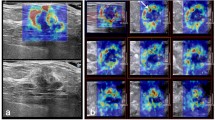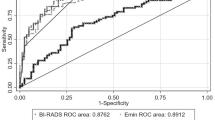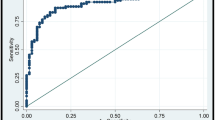Abstract
Objectives
To prospectively compare the diagnostic performances of two-dimensional (2D) and three-dimensional (3D) shear-wave elastography (SWE) for differentiating benign from malignant breast masses.
Methods
B-mode ultrasound and SWE were performed for 134 consecutive women with 144 breast masses before biopsy. Quantitative elasticity values (maximum and mean elasticity in the stiffest portion of mass, Emax and Emean; lesion-to-fat elasticity ratio, Erat) were measured with both 2D and 3D SWE. The area under the receiver operating characteristic curve (AUC), sensitivity and specificity of B-mode, 2D, 3D SWE and combined data of B-mode and SWE were compared.
Results
Sixty-seven of the 144 breast masses (47 %) were malignant. Overall, higher elasticity values of 3D SWE than 2D SWE were noted for both benign and malignant masses. The AUC for 2D and 3D SWE were not significantly different: Emean, 0.938 vs 0.928; Emax, 0.939 vs 0.930; Erat, 0.907 vs 0.871. Either 2D or 3D SWE significantly improved the specificity of B-mode ultrasound from 29.9 % (23 of 77) up to 71.4 % (55 of 77) and 63.6 % (49 of 77) without a significant change in sensitivity.
Conclusion
Two-dimensional and 3D SWE performed equally in distinguishing benign from malignant masses and both techniques improved the specificity of B-mode ultrasound.
Key Points
• Shear-wave elastography (SWE) is increasingly used during ultrasound of the breast
• 2D and 3D SWE performed equally in distinguishing benign from malignant masses
• Either SWE method, combined with B-mode, outperformed B-mode ultrasound alone
• Quantitative elasticity was greater for 3D than 2D SWE for all masses





Similar content being viewed by others
References
Berg WA (2004) Supplemental screening sonography in dense breasts. Radiol Clin North Am 42:845–851
Corsetti V, Ferrari A, Ghirardi M et al (2006) Role of ultrasonography in detecting mammographically occult breast carcinoma in women with dense breasts. Radiol Med 111:440–448
Gong X, Xu Q, Xu Z et al (2011) Real-time elastography for the differentiation of benign and malignant breast lesions: a meta-analysis. Breast Cancer Res Treat 130:11–18
Yi A, Cho N, Chang JM et al (2012) Sonoelastography for 1,786 non-palpable breast masses: diagnostic value in the decision to biopsy. Eur Radiol 22:1033–1040
Kearney TJ, Airapetian S, Sarvazyan A (2004) Tactile breast imaging to increase the sensitivity of breast examination. Journal of Clinical Oncology, 2004 ASCO Annual Meeting Proceedings (Post-Meeting Edition) Vol 22, No 14S (July 15 Supplement):1037
Cosgrove DO, Berg WA, Dore CJ et al (2012) Shear wave elastography for breast masses is highly reproducible. Eur Radiol 22:1023–1032
Berg WA, Cosgrove DO, Dore CJ et al (2012) Shear-wave elastography improves the specificity of breast US: the BE1 multinational study of 939 masses. Radiology 262:435–449
Evans A, Whelehan P, Thomson K et al (2010) Quantitative shear wave ultrasound elastography: initial experience in solid breast masses. Breast Cancer Res 12:R104
Chang JM, Moon WK, Cho N et al (2011) Clinical application of shear wave elastography (SWE) in the diagnosis of benign and malignant breast diseases. Breast Cancer Res Treat 129:89–97
Athanasiou A, Tardivon A, Tanter M et al (2010) Breast lesions: quantitative elastography with supersonic shear imaging—preliminary results. Radiology 256:297–303
Hamper UM, Trapanotto V, Sheth S et al (1994) Three-dimensional US: preliminary clinical experience. Radiology 191:397–401
Downey DB, Fenster A (1995) Vascular imaging with a three-dimensional power Doppler system. AJR Am J Roentgenol 165:665–668
Downey DB, Fenster A, Williams JC (2000) Clinical utility of three-dimensional US. Radiographics 20:559-571
Hamper UM, Trapanotto V, DeJong MR et al (1999) Three-dimensional US of the prostate: early experience. Radiology 212:719–723
Johnson DD, Pretorius DH, Budorick NE et al (2000) Fetal lip and primary palate: three-dimensional versus two-dimensional US. Radiology 217:236–239
Cho N, Moon WK, Cha JH et al (2006) Differentiating benign from malignant solid breast masses: comparison of two-dimensional and three-dimensional US. Radiology 240:26–32
Cho KR, Seo BK, Lee JY et al (2005) A comparative study of 2D and 3D ultrasonography for evaluation of solid breast masses. Eur J Radiol 54:365–370
D’Orsi CJ, Bassett LW, Berg WA (2003) Breast imaging reporting and data system, BI-RADS: Mammography, 4th edn. American College of Radiology, Reston
Mendelson EB, Baum JK, Berg WA et al (2003) Breast Imaging Reporting and Data System, BI-RADS: Ultrasound, 1st edn. American College of Radiology, Reston
Heinze G (2004) A SAS macro, S-PLUS library and R package to perform logistic regression without convergence problems. Medical University of Vienna, Vienna
Evans A, Whelehan P, Thomson K et al (2012) Invasive breast cancer: relationship between shear-wave elastographic findings and histologic prognostic factors. Radiology 263:673–677
Marusyk A, Almendro V, Polyak K (2012) Intra-tumour heterogeneity: a looking glass for cancer? Nat Rev Cancer 12:323–334
Longo DL (2012) Tumor heterogeneity and personalized medicine. N Engl J Med 366:956–957
Ginestier C, Charafe-Jauffret E, Birnbaum D (2012) What drives breast cancer heterogeneity: oncogenic events or cell of origin? J Pathol 227:267–269
Galardi F, Oakman C, Truglia MC et al (2012) Inter- and intra-tumoral heterogeneity in DNA damage evaluated by comet assay in early breast cancer patients. Breast 21:336–342
Barr RG (2012) Sonographic breast elastography: a primer. J Ultrasound Med 31:773–783
Garra BS (2007) Imaging and estimation of tissue elasticity by ultrasound. Ultrasound Q 23:255–268
Tozaki M, Isobe S, Fukuma E (2011) Preliminary study of ultrasonographic tissue quantification of the breast using the acoustic radiation force impulse (ARFI) technology. Eur J Radiol 80:182–187
Chang JM, Moon WK, Cho N, Kim SJ (2011) Breast mass evaluation: factors influencing the quality of US elastography. Radiology 259:59–64
Acknowledgments
This research was supported by grant number (04-2011-0280) from Seoul National University Hospital Research Fund and the Converging Research Center Program through the Ministry of Education, Science and Technology (2012 K001499).
Author information
Authors and Affiliations
Corresponding author
Rights and permissions
About this article
Cite this article
Lee, S.H., Chang, J.M., Kim, W.H. et al. Differentiation of benign from malignant solid breast masses: comparison of two-dimensional and three-dimensional shear-wave elastography. Eur Radiol 23, 1015–1026 (2013). https://doi.org/10.1007/s00330-012-2686-9
Received:
Revised:
Accepted:
Published:
Issue Date:
DOI: https://doi.org/10.1007/s00330-012-2686-9




